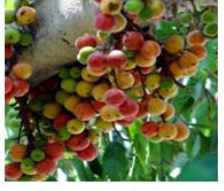Review article of Phytochemical and Pharmacological activity of Achyranthes aspera, Ficus glomerata and Leucas aspera and Microbial activity test The medicinal potential of medicinal plants is a well-known phenomenon from centuries. This review article i
Keywords:
Phytochemical, Pharmacological, Achyranthes aspera, Ficus glomerata, Leucas aspera, Microbial activity testAbstract
The medicinal potential of medicinal plants is a well-known phenomenon from centuries. This review article is focus on the phytochemical, pharmacological, and microbial activity of three medicinal plants as Achyranthes aspera (Amaranthaceae), Ficus glomerata (Moraceae) and Leucas aspera ( Lamiaceae).its is rich sourse of bioactive compounds as alkaloids, flavonoids, tannins, saponins, phenolic compounds, and terpenoids. Its Various pharmacological activities have been reported as Hepatoprotective and antioxident property DNA Damage protective activity immunomodulatory activity Antifungal activity Antimicrobial activity Antinociceptive activity antioxidant and cytotoxic activities. for the antimicrobial activity 80% methenol is use . in which use , E.Coli, K.pneumoniae and S.typhi bacteria.
Downloads
References
AR Bafna, and SH Mishra. (2004). Effect of methanol extract of Achyranthes aspera Linn. on rifampicin-induced hepatotoxicity in rats. Ars Pharmaceutica 45:343–351.
A Chakraborty, A Brantner, T Mukainaka, Y Nobukuni, M Kuchide, T Konoshima, H Tokuda, and H Nishino. (2002). Cancer chemopreventive activity of Achyranthes aspera leaves on Epstein-Barr virus activation and two-stage mouse skin carcinogenesis. Cancer Lett 177:1–5.
AB Gokhale, AS Damre, KR Kulkami, and MN Saraf. (2002), Preliminary evaluation of anti-inflammatory and anti-arthritic activity of S. lappa, Achyranthes speciosa and Achyranthes aspera. Phytomedicine 9:433–437.
Tahiliani P, Kar A.elevates the Achyranthes aspera for thyroid hormone levels and decreases hepatic lipid peroxidation in male rats. J Ethnopharmaco,. 2000 Aug;71(3):527-32.
K Sandhyakumary, RG Boby, and M Indira. (2002), Impact of feeding ethanol extracts of Achyranthes aspera Linn.on reproductive functions in male rats. Indian J Exp Biol 40:1037–1039
DK Verma, SK Singh, and V Tripathi. (1997). A rare antibacterial activity of Achyranthes aspera Linn. Indian Drugs 34:32–35..
G Rao. (2002).,Immunomodulatory activity of Achyranthes aspera on the elicitation of antigen specific murine antibody response. Int J Pharmacog 40:175–178.
V Wadhwa, MM Singh, DN Gupta, C Singh, and VP Kamboj. (1986), Contraceptive and hormonal properties of Achyranthes aspera in rats and hamsters. Planta Med 3:231–233.
Das AK, Bigoniya P, Verma NK, Rana AC. Gastroprotective effect of Achyranthes aspera Linn. leaf on rats. Asian Pac J Trop Med. 2012 Mar.
Verma AR, Vijayakumar M, Rao CV, Mathela CS. In vitro and in vivo antioxidant properties and DNA damage protective activity of green fruit of Ficus glomerata, Food Chem Toxicol,2010 Feb.
Chandrasekar SB, Bhanumathy M, Pawar AT, Somasundaram T. Phytopharmacology of Ficus religiosa. Pharmacogn Rev. 2010 Jul;4(8):195-9. doi: 10.4103/0973-7847.70918. PMID: 22228961; PMCID: PMC3249921.
Sheetal A, Bagul MS, Prabia M, Rajani M. Evaluation of free radicals scavenging activity of an Ayurvedic formulation, panchvankala. Indian J Pharm Sci. 2008.
Oliver bever B. Oral hypoglycaemic plants in West Africa. J Ethnopharmacol, 1977.
Khare CP. Encyclopedia of Indian medicinal plants. Berlin Heidelberg, New York, Springer-Verlag,2004.
Bushra S, Farooq A. Flavonols (kaempeferol, quercetin, myricetin) contents of selected fruits, vegetables and medicinal plants, Food Chem. 2008.
Ruby J, Nathan PT, Balasingh J, Kunz TH. Chemical composition of fruits and leaves eaten by short- nosed fruit bat, Cynopterus sphinx. J Chem Ecol. 2000.
Channabasavaraj KP, Badami S, Bhojraj S. Hepatoprotective and antioxidant activity of methanol extract of Ficus glomerata. J Nat Med. 2008 Jul.
Verma AR, Vijayakumar M, Rao CV, Mathela CS. In vitro and in vivo antioxidant properties and DNA damage protective activity of green fruit of Ficus glomerata. Food Chem Toxicol. 2010 Feb.
Heroor S, Beknal AK, Mahurkar N. Immunomodulatory activity of methanolic extracts of fruits and bark of Ficus glomerata Roxb. in mice and on human neutrophils. Indian J Pharmacol. 2013 Mar-Apr;45(2):130-5. doi: 10.4103/0253-7613.108287. PMID: 23716887; PMCID: PMC3660923.
Ravindran R, Juliet S, Sunil AR, Kumar KG, Nair SN, Amithamol KK, Shynu M, Rawat AK, Ghosh S. Eclosion blocking effect of ethanolic extract of Leucas aspera (Lamiaceae) on Rhipicephalus (Boophilus) annulatus. Vet Parasitol. 2011 Jun 30;179(1-3):287-90. doi: 10.1016/j.vetpar.2011.02.021. Epub 2011 Mar 4. PMID: 21440993.
Kamat M, Singh TP. Preliminary chemical examination of some compounds in the different parts of the genus Leucas. Geobios. 1994.
Chaudhury NA, Ghosh D. Insecticidal plants: Chemical examination of Leucas aspera. J Indian Chem Soc. 1969.
Mangathayaru K, Thirumurugan D, Patel PS, Pratap DV, David DJ, Karthikeyan J. Isolation and identification of nicotine from leucas aspera (willd) Indian J Pharm Sci. 2000.
Khaleque A, Huq ME, Huq MS, Mansoor MH. Chemical investigations on Leucas aspera. I. Isolation of compound-A, 3-sitosterol and et-sitosterol from the aerial parts. Scientifi c Res. 1970.
Chatterjee SK, Majumdar DN. Chemical investigation of Leucas aspera. J Inst Chem. 1969.
Sadhu SK, Okuyama E, Fujimoto H, Ishibashi M. Diterpenes from Leucas aspera inhibiting prostaglandin-induced contractions. J Nat Prod. 2006.
Sadhu SK, Okuyama E, Fujimoto H, Ishibashi M. Separation of Leucas aspera, a medicinal plant of Bangladesh, guided by prostaglandin inhibitory and antioxidant activities. Chem Pharm Bull (Tokyo) 2003.
Kalachaveedu M, Ghosh A, Ranjan R, VedamVenkat K. Volatile constituents of Leucas aspera (WilId.) J Essent Oil Res. 2006.
Jam MP, Nath HB. Examination of the component fatty acids of the oil from the seeds of Leucas aspera. Lab Dev. 1968.
Badami RC, Patil KB. Minor seed oils.X: Physico-chemical characteristics and fatty acid composition of seven minor oils. J Oil Technol Assoc India. 1975.
Misra TN, Singh RS, Pandey HS, Singh S. A novel phenolic compound from Leucas aspera Spreng. Indian J Chem Br. 1995.
Misra TN, Singh RS, Prasad C, Singh S. Two aliphatic ketols from Leucas aspera. Phytochemistry. 1992.
Misra TN, Singh RS, Pandey HS, Singh S. Long-chain compounds from Leucas aspera. Phytochemistry. 1992.
Pradhan B, Chakraborty D, Subba G. A triterpenoid lactone from Leucas aspera. Phytochemistry. 1990.
Thakur DK, Misra SK, Choudhuri PC. In vitro trials of plant extracts and chemicals for their antifungal activity. Indian J Animal Health. 1987;26:31–5.
Mangathayaru K, Lakshmikant J, Shyam Sundar N, Swapna R, Grace XF, Vasantha J. Antimicrobial activity of Leucas aspera flowers. Fitoterapia. 2005;76:752–4. doi: 10.1016/j.fitote.2005.08.009.
Rahman MS, Sadhu SK, Hasan CM. Preliminary antinociceptive, antioxidant and cytotoxic activities of Leucas aspera root. Fitoterapia. 2007;78:552–5. doi: 10.1016/j.fitote.2006.06.018.
Maryzzella, J.C. and practical , A.H.,J.Am.Pharm. Assoc., 47,471 (1958).
Marian, T.G., Murthy, P.N. Ranganatham, P.Hymete, A. and Daka, K.The Eastern Pharmacist, Vol 36, No.33,131 (1993)

Downloads
Published
How to Cite
Issue
Section
License

This work is licensed under a Creative Commons Attribution 4.0 International License.
Current Clinical and Medical Education













